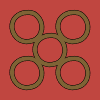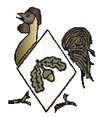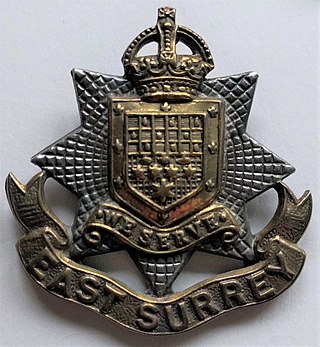
The 32nd Division was an infantry division of the British Army that was raised in 1914, during the First World War. The division was raised from volunteers for Lord Kitchener's New Armies, made up of infantry 'Pals battalions' and artillery brigades raised by public subscription or private patronage. The division was taken over by the War Office in September 1915. It served in France and Belgium in the trenches of the Western Front for the duration of the war. It saw action at the Battle of the Somme, the Pursuit to the Hindenburg Line, the Defence of Nieuport, the German spring offensive, and the Allied Hundred Days Offensive beginning at the Battle of Amiens. After the Armistice it marched into Germany as part of the Army of Occupation.
The 14th Infantry Brigade was a British Army formation during the Second Boer War, World War I, when it served on the Western Front, and World War II, when it fought in Crete and Tobruk, and then as Chindits in Burma.
The 19th Brigade is an Army Reserve formation of the British Army. As the 19th Infantry Brigade, it fought in the First and Second World War.

The 40th Division was an infantry division of the British Army active during the First World War, where it served on the Western Front. It was a division of Lord Kitchener's New Army volunteers, mostly "bantam" recruits of below regulation height. It was later briefly reformed as a deception formation in the Second World War, and during the early years of the Cold War was recreated a third time to garrison Hong Kong.

42nd Brigade was an infantry formation of the British Army during both World Wars. It was formed in August 1914 as part of Kitchener's Army, and was assigned to the 14th (Light) Division, serving on the Western Front. It was reformed in World War II for line of communication and deception purposes. As 42 Brigade it became a regional headquarters from 1982 to 2017.

152nd Infantry Brigade was a formation of Britain's Territorial Force/Territorial Army that was part of 51st (Highland) Division in both World Wars. From its origins in the 19th Century Volunteer Force it was based in Inverness and was composed of Highland battalions. It served on the Western Front in World War I, and after it was captured at Saint-Valery-en-Caux early in World War II it was reformed from its 2nd Line and saw action in North Africa, Sicily and North West Europe.

153rd Infantry Brigade was a formation of Britain's Territorial Force/Territorial Army that was part of 51st (Highland) Division in both World Wars. From its origins in the 19th Century Volunteer Force it was based in Aberdeen and was composed of Highland battalions. It served on the Western Front in World War I, and after it was captured at Saint-Valery-en-Caux early in World War II it was reformed from its 2nd Line and saw action in North Africa, Sicily and North West Europe. It continued serving postwar until the reduction of the Territorial Army in the 1960s.

154th Infantry Brigade was a formation of Britain's Territorial Force/Territorial Army that was part of 51st (Highland) Division in both World Wars. From its origins in the 19th Century Volunteer Force it was based in Stirling and was composed of Highland battalions. It served on the Western Front in World War I, and after it escaped from France early in World War II it was reformed from its 2nd Line and saw action in North Africa, Sicily and North West Europe. It continued serving postwar until the reduction of the Territorial Army in the 1960s.
227th Brigade was an infantry formation of the British Army formed for Home Service under various short-lived titles in the First and the Second World Wars. Later it was upgraded to a field formation composed of Scottish troops, and saw heavy fighting in the Normandy and North West Europe Campaign.
The 157th Brigade was an infantry brigade of the British Army. The brigade fought in both the First and the Second World Wars, assigned to 52nd (Lowland) Infantry Division.
The 214th Brigade was an infantry formation of the British Army during World War I. It was raised as a second line brigade of the Territorial Force and initially assigned to the 71st Division for coast defence. Later it was reorganised as an all-arms brigade group for service in North Russia, but this was cancelled and it was reassigned to the 67th Division, a training and home defence formation, until the end of the war.
The 216th Brigade was a Home Service formation of the British Army during the First and the Second World Wars.
The 119th Brigade, originally the Welsh Bantam Brigade, was an infantry brigade formation of the British Army during World War I. Part of Lord Kitchener's 'New Armies', it was formed of men under the normal regulation height, known as bantams. It served in the 40th Division on the Western Front, distinguishing itself in actions against the Hindenburg Line and the capture of Bourlon Wood. It was reorganised as a conventional brigade in early 1918 and served until the end of the war. The brigade number was reactivated for deception purposes during World War II.
The 121st Brigade was an infantry brigade formation of the British Army during World War I. Part of Lord Kitchener's 'New Armies', it served in the 40th Division on the Western Front. The brigade number was reactivated for deception purposes during World War II.
The 196th Brigade was an infantry brigade of the British Army raised during the Great War in 1914. The brigade was formed as a 2nd Line of the 157th Brigade and assigned to the 65th Division, itself formed as a 2nd Line of the 52nd (Lowland) Division. The brigade was composed of four 2nd Line battalions of the Highland Light Infantry and remained in the United Kingdom throughout the war.
221st Mixed Brigade was a Scottish Home Service formation of the British Army that served under various titles throughout World War I.
71st Division was a short-lived infantry division of the British Army during the First World War. It served in the Home Defence forces and never went overseas.
Brigadier-General Charles Strathavon Heathcote-Drummond-Willoughby, was a British Army officer in the Second Boer War and World War I.

The 13th (Service) Battalion, East Surrey Regiment (Wandsworth) was an infantry unit recruited as part of 'Kitchener's Army' in World War I. It was raised in the summer of 1915 by the Mayor and Borough of Wandsworth in the suburbs of South London. It served on the Western Front from June 1916, and distinguished itself at the capture of Villers-Plouich and at Bourlon Wood. It then fought through the German spring offensive and the Battle of the Lys, when most of the battalion was surrounded and captured. Reduced to a training cadre the battalion was sent back to England to be reconstituted, but was eventually disbanded just before the end of the war

The 12th (Service) Battalion, South Wales Borderers was a Welsh Bantam battalion recruited in World War I as part of 'Kitchener's Army' from men who were below the normal minimum height required by the British Army. It formed part of the Welsh Bantam Brigade, later 119th Brigade, and served on the Western Front. It saw a good deal of action along the Hindenburg Line and at Cambrai before being broken up early in 1918 to provide reinforcements to other units.





